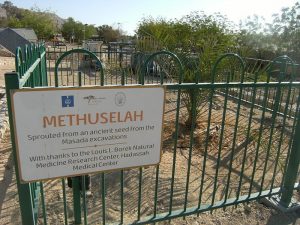A tree grown from a 2,000-year-old seed may bring its sub-species back to Israel, where it once flourished, after a millennium-long absence.
The seed was one of six discovered in 1963, in a jar in Herod the Great’s palace at the Masada fortress in Israel. Radiocarbon dating found that the seeds, preserved by the arid climate, were from some time between 155 B.C. and A.D. 64.
In 2005, Elaine Solowey, from the Center for Sustainable Agriculture at the Arava Institute for Environmental Studies, decided to try planting three of them. She was skeptical and supposed that the seeds’ endosperm, which fuels its early growth, would no longer be viable. The seed was treated with a hormone-rich solution and fertilizer and then planted on the grounds of the institute in Ketura.
One soon sprouted into a sapling. Twelve years later, it is more than 10 feet tall. A male of its sub-species, it was nicknamed Methuselah after the longest-lived person in the Bible. It is the oldest known germination of a seed in the world.
world.
At first, the leaves were plagued with white blotches, suggesting insufficient nutrients, but eventually, the plant thrived. It first flowered in 2011 and it produces pollen, which enables it to reproduce with modern date palms, as it did in 2015.
The Judean date palm has deep cultural meaning in the region. In the Bible, King David names his daughter Tamar, which is the Hebrew word for the plant. Date palms feature on both ancient Hebrew and modern Israeli currency. Despite this long regional history, the sub-species was wiped out by years of devastation from wars and foreign rule.
Solowey has grown more Judean date palms from the other ancient seeds since the success of Methuselah and is working on growing a grove of the resurrected variety. Others are investigating the medicinal properties it is reported to have, which modern date palms don’t appear to share.
Originally posted on Atlas Obscura.
